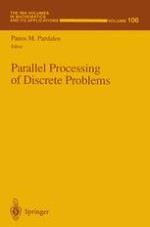1999 | OriginalPaper | Buchkapitel
Large-Scale Structured Discrete Optimization via Parallel Genetic Algorithms
verfasst von : Ioannis T. Christou, W. W. Donaldson, R. R. Meyer
Erschienen in: Parallel Processing of Discrete Problems
Verlag: Springer New York
Enthalten in: Professional Book Archive
Aktivieren Sie unsere intelligente Suche, um passende Fachinhalte oder Patente zu finden.
Wählen Sie Textabschnitte aus um mit Künstlicher Intelligenz passenden Patente zu finden. powered by
Markieren Sie Textabschnitte, um KI-gestützt weitere passende Inhalte zu finden. powered by
We consider the application of parallel “island” genetic algorithms (GA’s) to the solution of large-scale discrete optimization problems with block structure. Optimization problems arising in a variety of important applications have block-structured objective functions and constraint sets, i.e., large subsets of variables and constraints that may be naturally clustered because of spatial or temporal contexts. For continuous optimization problems, many iterative decomposition techniques (such as the Dantzig-Wolfe method) have been developed that take advantage of this block structure by alternating between the solution of subproblems that deal with separate blocks in a decentralized manner (allowing the exploitation of parallel and distributed computation) and coordination phases in which subproblem solutions are combined in such a way as to obtain good solutions of the original problem. However, these approaches are not readily extended to discrete optimization because traditional coordination mechanisms generally do not preserve the discrete nature of the variables. This paper describes the use of GA’s as a parallel coordination technique for discrete optimization. To illustrate this approach, we consider a class of structured discrete geometric problems motivated by applications in database and the solution of partial differential equations. The most regular type of problem of this class is the determination of a minimum perimeter partition into P equal-area subdomains of an MxN grid, where P,M, and N are the input parameters, and perimeter is defined as the total perimeter of the P subdomains. (Regarding perimeter of a subdomain as energy, this can be thought of as a minimum energy equipartition.) For problems of this type involving millions of variables, high-level genetic algorithms that take advantage of block structure for genotype-phenotype differentiation provide a successful approach for the parallel coordination of subproblem solutions. Extensions to more general classes of problems are also presented.
